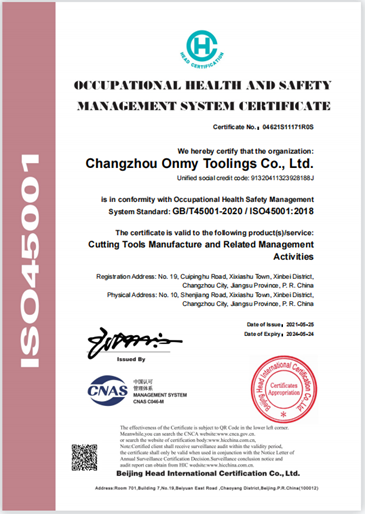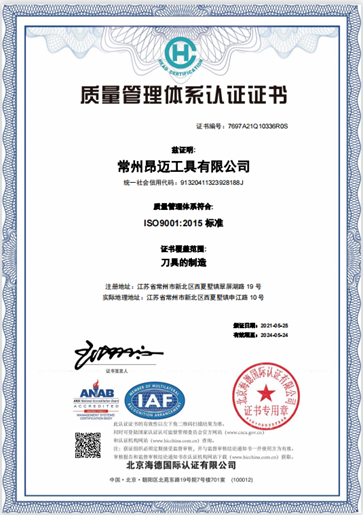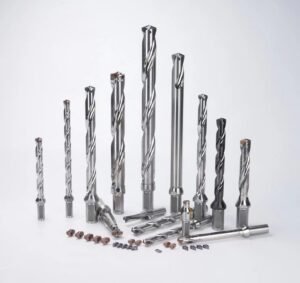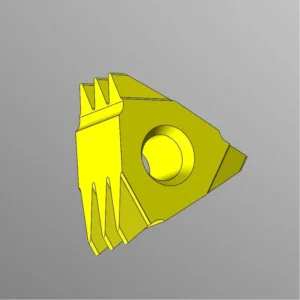آپ کا قابل اعتماد چین کاربائڈ پروڈیوسر داخل کرتا ہے
پریمیم چین کاربائڈ زیادہ سے زیادہ کارکردگی کے لئے داخل کرتا ہے
اونمی ٹولز میں خوش آمدید ، اعلی معیار کے کاربائڈ داخل کرنے کے ل your آپ کے پاس جانے والا ذریعہ۔ کاربائڈ داخل کرنے والے ایک معروف سپلائر کی حیثیت سے ، ہم پریمیم چین کاربائڈ داخل کرنے میں مہارت رکھتے ہیں جو مشینی سب سے زیادہ تقاضوں کو پورا کرتے ہیں۔ ہماری مصنوعات کی وسیع رینج ، بشمول اعلی درجے کے ٹرننگ داخل کرنے کو یقینی بناتی ہے کہ آپ کو اپنی مینوفیکچرنگ کی ضروریات کا بہترین حل مل جائے گا۔
اونمی ٹولز میں خوش آمدید
آج کے مسابقتی مینوفیکچرنگ زمین کی تزئین میں ، صحت سے متعلق کامیابی کی کلید ہے۔ مشینی کارروائیوں میں کاربائڈ داخل کرنے والے اعلی درجے کی درستگی اور کارکردگی کے حصول میں اہم کردار ادا کرتے ہیں۔ ایک تجربہ کار چائنا کاربائڈ داخل کرنے والے سپلائر کی حیثیت سے ، ہم ان چھوٹے لیکن طاقتور اجزاء کے آپ کے پیداواری عمل پر ہونے والے اہم اثرات کو سمجھتے ہیں۔
ہمارے چائنا کاربائڈ داخلوں کو غیر معمولی کارکردگی ، استحکام اور لاگت کی تاثیر کی فراہمی کے لئے انجنیئر ہیں۔ چاہے آپ داخل کرنے ، گھسائی کرنے والے داخل ، یا خصوصی حل تلاش کر رہے ہو ، ہمارے پاس آپ کی عین مطابق خصوصیات کو پورا کرنے کے لئے مہارت اور مصنوعات کی حد موجود ہے۔
چین اونمی کاربائڈ داخل کرنے کا انتخاب کیوں کریں؟
بے مثال معیار اور صحت سے متعلق
اونمی ٹولز میں ، ہم کاربائڈ داخل کرنے کی پیش کش پر فخر کرتے ہیں جو معیار اور صحت سے متعلق اعلی ترین معیار پر پورا اترتے ہیں۔ ہماری داخلیاں جدید ترین تکنیک اور پریمیم مواد کا استعمال کرتے ہوئے تیار کی جاتی ہیں ، جس سے مستقل کارکردگی اور طویل ٹول لائف کو یقینی بنایا جاتا ہے۔ ہر داخل کرنے سے سخت کوالٹی کنٹرول چیک سے گزرتا ہے اس بات کی ضمانت کے لئے کہ یہ آپ کے ہاتھوں تک پہنچنے سے پہلے ہمارے پُرجوش معیارات پر پورا اترتا ہے۔
مصنوعات کی جامع رینج
ایک معروف کاربائڈ داخل کرنے والے سپلائر کے طور پر ، ہم مختلف مشینی ایپلی کیشنز کو پورا کرنے کے لئے داخل کرنے کا ایک وسیع انتخاب پیش کرتے ہیں۔ عمومی مقصد سے لے کر داخل ہونے سے لے کر خصوصی گھسائی کرنے والی اور سوراخ کرنے والی داخلوں تک ، ہمارا کیٹلاگ شکلوں ، سائز اور درجات کے وسیع میدان عمل کا احاطہ کرتا ہے۔ یہ تنوع آپ کو اپنی مخصوص ضروریات کے لئے کامل داخل کرنے کی اجازت دیتا ہے ، اپنی مشینی عمل کو بہتر بناتا ہے اور مجموعی طور پر پیداواری صلاحیت کو بہتر بناتا ہے۔
لاگت سے موثر حل
ایک قابل اعتماد چین کاربائڈ داخل کرنے والے فراہم کنندہ کی حیثیت سے ہماری حیثیت ہمیں معیار پر سمجھوتہ کیے بغیر انتہائی مسابقتی قیمتوں کی پیش کش کرنے کی اجازت دیتی ہے۔ ہمیں اپنے ٹرننگ داخل کرنے والے سپلائر کے طور پر منتخب کرنے سے ، آپ کو سخت کوالٹی کنٹرول اقدامات کے ساتھ مل کر چینی مینوفیکچرنگ کے لاگت کے فوائد سے فائدہ ہوتا ہے۔ اس سے آپ کو اپنے ٹولنگ کے اخراجات کو کم کرنے کے قابل بناتا ہے جبکہ آپ کی پیداوار کے مطالبات کو اعلی معیارات کو برقرار رکھتے ہوئے۔
صنعتیں جن کی ہم خدمت کرتے ہیں
ایک قابل اعتماد چائنا کاربائڈ داخل کرنے والے سپلائر کی حیثیت سے ، ہم بہت ساری صنعتوں کو پورا کرتے ہیں ، جن میں شامل ہیں:

آٹوموٹو
انجن کے اجزاء ، ٹرانسمیشن پارٹس ، اور بہت کچھ کے لئے داخل کرنے کی فراہمی

ایرو اسپیس
اہم طیاروں اور خلائی جہاز کے اجزاء کے ل high اعلی صحت سے متعلق داخل کی فراہمی

تیل اور گیس
سوراخ کرنے والے سامان اور پائپ لائن کے اجزاء کے لئے پائیدار داخل کی پیش کش

عام مینوفیکچرنگ
مختلف شعبوں میں متنوع مشینی کی ضروریات کی حمایت کرنا

میڈیکل
طبی آلات اور ایمپلانٹس کی تیاری کے لئے صحت سے متعلق داخل کی فراہمی

ڈائی اور سڑنا
پیچیدہ سڑنا بنانے کے لئے خصوصی داخلوں کی فراہمی
ہمارے ساتھ شراکت کے فوائد
- ماہر تکنیکی مدد
تجربہ کار انجینئرز کی ہماری ٹیم آپ کی مخصوص ایپلی کیشنز کے لئے صحیح کاربائڈ داخل کرنے کے انتخاب میں آپ کی مدد کے لئے ہمیشہ تیار رہتی ہے۔ ہم آپ کو مشینی عمل کو بہتر بنانے اور کسی بھی مسئلے کا ازالہ کرنے میں مدد فراہم کرتے ہیں جو آپ کو درپیش ہیں۔
- تیز اور قابل اعتماد ترسیل
ہم آپ کے پیداواری نظام الاوقات کو برقرار رکھنے میں بروقت ترسیل کی اہمیت کو سمجھتے ہیں۔ ایک قابل کار کاربائڈ داخل کرنے والے سپلائر کی حیثیت سے ، ہم معیاری داخلوں کی ایک بڑی انوینٹری کو برقرار رکھتے ہیں اور کسٹم آرڈرز کے ل quick فوری طور پر بدلتے ہیں۔ ہمارا موثر لاجسٹک نیٹ ورک اس بات کو یقینی بناتا ہے کہ آپ کے احکامات فوری طور پر آپ تک پہنچیں ، ٹائم ٹائم کو کم سے کم کریں اور اپنے کاموں کو آسانی سے چلائیں۔
- تخصیص کی صلاحیتیں
ہر مینوفیکچرنگ کا عمل انوکھا ہوتا ہے ، اور بعض اوقات شیلف حل کافی نہیں ہوتے ہیں۔ ہماری اندرون ملک ریسرچ اینڈ ڈویلپمنٹ ٹیم آپ کے ساتھ اپنی مرضی کے مطابق کاربائڈ داخل کرنے کے لئے کام کر سکتی ہے جو آپ کی مخصوص ضروریات کو بالکل ٹھیک کرتی ہے۔ یہ لچک آپ کو اعتماد کے ساتھ انتہائی مشکل مشینی کاموں سے بھی نمٹنے کی اجازت دیتی ہے۔
- مسابقتی قیمتوں کا تعین
چین کاربائڈ سپلائر داخل کرنے کے طور پر ، ہم سخت معیار کے معیار کو برقرار رکھتے ہوئے چینی مینوفیکچرنگ کے لاگت کے فوائد کا فائدہ اٹھاتے ہیں۔ اس سے ہمیں آپ کو اپنی مصنوعات کی کارکردگی اور وشوسنییتا پر سمجھوتہ کیے بغیر انتہائی مسابقتی قیمتوں کی پیش کش کی جاسکتی ہے۔ ہمیں اپنے ٹرننگ داخل کرنے والے سپلائر کے طور پر منتخب کرکے ، آپ اپنے ٹولنگ کے اخراجات کو نمایاں طور پر کم کرسکتے ہیں اور اپنی نچلی لائن کو بہتر بناسکتے ہیں۔
معیار سے ہماری وابستگی
کوالٹی ہر اس چیز کے دل میں ہے جو ہم اونمی ٹولنگز میں کرتے ہیں۔ ایک معروف کاربائڈ داخل کرنے والے سپلائر کے طور پر ، ہم نے اپنے پورے پیداوار کے عمل میں سخت کوالٹی کنٹرول اقدامات کو نافذ کیا ہے۔ ہماری مینوفیکچرنگ کی سہولیات جدید ترین جانچ کے سازوسامان سے لیس ہیں ، اس بات کو یقینی بناتے ہیں کہ ہر داخل ہمارے احاطے کو چھوڑنے سے پہلے ہمارے پُرجوش معیارات کو پورا کرے۔
ہمیں آئی ایس او 9001: 2015 اور آئی ایس او 45001 سرٹیفیکیشن رکھنے پر فخر ہے ، ایک مضبوط کوالٹی مینجمنٹ سسٹم کو برقرار رکھنے کے اپنے عزم کا مظاہرہ کرتے ہوئے۔ مزید برآں ، ہماری مصنوعات مختلف مشینی نظاموں میں مطابقت اور کارکردگی کی ضمانت دینے والے ، اے این ایس آئی اور ڈی آئی این جیسے بین الاقوامی معیارات کی تعمیل کرتی ہیں۔


30+ ممالک سے ہمارے خوش کن کلائنٹس

جیمز کنگ

جوانا فاکس

فیلیسیٹی ٹرمپ
ہمارے آرڈرنگ کا عمل
اونمی ٹولز سے آرڈر دینا آسان اور سیدھا ہے:
- ہماری آن لائن کیٹلاگ کو براؤز کریں یا مصنوعات کی معلومات کے ل our ہماری سیلز ٹیم سے رابطہ کریں۔
- مطلوبہ کاربائڈ داخل کریں کو منتخب کریں یا کسٹم حوالہ کی درخواست کریں۔
- اپنی مخصوص ضروریات اور مقدار کی ضرورت فراہم کریں۔
- اپنے آرڈر کی تفصیلات کا جائزہ لیں اور اس کی تصدیق کریں۔
- اپنے ترجیحی ادائیگی کا طریقہ منتخب کریں اور لین دین کو مکمل کریں۔
- آرڈر کی تصدیق اور تخمینہ ترسیل کی تاریخ وصول کریں۔
- اپنی کھیپ کو ٹریک کریں اور آمد کے لئے تیاری کریں۔

بڑے یا بار بار چلنے والے احکامات کے ل we ، ہم ہموار عمل اور ممکنہ حجم کی چھوٹ کی پیش کش کرتے ہیں۔ اپنی مخصوص ضروریات پر تبادلہ خیال کرنے کے لئے ہماری سیلز ٹیم سے رابطہ کریں۔
آپ کا قابل اعتماد چین کاربائڈ پروڈیوسر
ایک اعلی درجے کی کاربائڈ داخل کرنے والے سپلائر کے ساتھ کام کرنے کے فرق کا تجربہ کرنے کے لئے تیار ہیں؟ ہم آپ کی مدد کے لئے یہاں موجود ہیں













